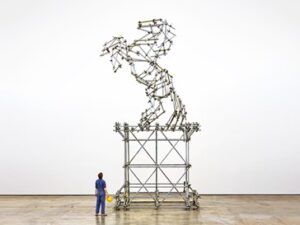Scaffolding has been used around the world for centuries to create temporary support structures. Sometimes, these allow for rebuilding or maintenance; at other times they form bridges. They might create new viewpoints (think Grand Canyon) or create jumping-off points (think bungee). They are tangible. Whether bamboo or metal, connected with bolts or string, they provide a solid body that can be redesigned, rebuilt and reimagined.
When thinking about young people and the challenges they face, the idea of scaffolding helps us visualise how different people, at different moments, need different support structures.

A joined-up approach
Within the civic journey programme, the notion of scaffolding brings a real-world focus on the ‘nuts and bolts’ of forms of support, issues of accessibility, service quality and ‘joined-up’ policy making.
In education, ‘scaffolding’ is used to describe how we create the right environment to empower young people to take ownership of their learning journey, considering the types of issues that engage people to be active learners; what experiences would build their knowledge and drive them to do more in future; what other support they need in their education environment and their family life to make the most of the experiences, and more. It also looks at how the system puts pressure on young people or creates ‘traps’ – for example, with exams that give a young person only one or two shots to get the grades they need to get a job or go to university.
Of course, education is just one space – and while improving support for young people in one part of their life is always welcome, they might be failed by other parts. When we adapt this to a whole journey, this focus on ‘joining up’ shows why the civic journey idea is potentially transformative while at the same time being incredibly challenging.
‘Social scaffolding’ and civic support
Crutches, slings and the plaster casts that are used to support broken bones can all be seen as forms of supportive scaffolding – but can we take this idea further and think in terms of social scaffolding and support for young people?
What do I mean by this? I mean the support structures that young people can rely on to nurture and protect them in life, and to help them learn about how the world works and how to change things.
The first and most obvious form of social scaffolding is provided by family and friends through the ups and downs of life. The level of support a young person might enjoy here can vary massively.
The second example covers school, clubs, sport, hobbies, college, work and all the other activities that add not only structure to a life but also a sense of belonging. These activities help young people develop new skills, meet new people, become more confident, cry when they need to cry and laugh when they want to laugh. But, again, we lack equality of opportunity when it comes to joining clubs or accessing work.
The third example is more formal and political. In many ways the whole notion of citizenship is designed to create and nourish a form of social or ‘civic’ scaffolding. The structures here include the education system, policing, the NHS, benefits and social care – far from perfect but all designed to provide what is often referred to as a ‘social safety net’. Once again, this example raises issues about standards of provision and equality of access to support across different sections of society.
In a rapidly changing world, the Civic Journey programme asks whether the right social scaffolding is in place to support young people to reach their full potential as both individuals and active members of a broader community. This encourages us to adopt a (re)design perspective, and helps us work collaboratively to build and rebuild the required support.
Find out more about the youth-led Civic Journey programme
Institute for Community Studies Posted on: 17 February 2023
